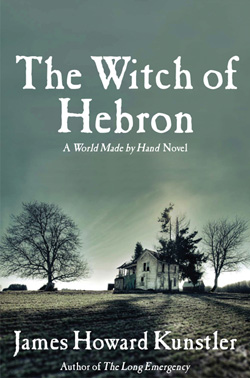
James Howard Kunstler -- World News Trust
Aug. 14, 2010 -- The Witch of Hebron is the sequel to World Made By Hand, a story of the post-oil American future. It is set in and around the town of Union Grove, Washington County, New York. The time is several months after the action in the first book, the week before Halloween.
This excerpt concerns Stephen Bullock, the wealthy landowner whose plantation is home to dozens of people whose lives and livelihoods had gone adrift in the collapse of the American economy.
Bullock Meets the Enemy
The last thing Stephen Bullock did before bedtime, in his capacity as town magistrate, was to sign a warrant directing Doctor Jeremy Copeland to exhume and examine the body of Shawn Watling and report his findings, costs of which, labor included, were to be billed to the town of Union Grove, repayable in up to four dollars silver coin. He gave the folded and sealed document to his chore-man, Roger Lippy, for delivery in person the following morning. Then Stephen Bullock retired to the bedroom upstairs in the large manor house that was the beating heart of his four thousand acre holdings.
The spacious, cheerful bedroom, was wallpapered in a motif that featured pink cabbage roses, with a likewise flowery chintz upholstered wing-chair in one corner. His wife Sophie's dressing table stood between two large light-gathering windows, with curtains that matched the wall-paper. Two nineteenth century landscapes of the upper Hudson Valley by the painter Hastings Lembert (1824 - 93), an ancestor, hung on the wall above a fine early Meiji (1871) tansu chest of drawers in kiriwood and chestnut. Bullock had picked it up forty years ago during his post-college sojourn in Kyoto teaching English.
Sophie sat in bed reading by the light of her bedside electric lamp. Bullock's farm was the only establishment in the vicinity of Union Grove that still enjoyed electricity. It was thanks to a small hydroelectric generator where the Battenkill made one final ten foot leap before it flowed into the Hudson River. It put out fifty kilowatts of power, enough to light the main house, the barns, the workshops, and the cottages his "employees" had constructed for themselves on his property. Finding replacement light bulbs was a problem now that trade had fallen off so sharply. He'd laid in as many as possible during the hoarding times that followed the bombings in Washington and Los Angeles and the fall of the government, but his supply had run down so severely that he'd had to stop giving new ones to his cottagers - they were going back to candles - and light bulbs were not the kind of thing he was equipped to manufacture on the farm, though his workshops did turn out many useful items from glassware to harnesses.
more
http://worldnewstrust.com/all-items/item/8134-vacation-special-excerpt-from-qthe-witch-of-hebronq-james-howard-kunstler.html